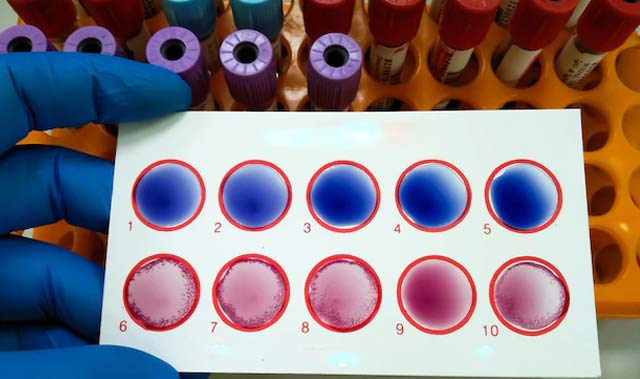Serology is a blood test to detect the presence of antibodies against a microorganism. Certain microorganisms stimulate the body to produce antibodies during an active infection.
Blood is drawn from a vein, usually from the inside of the elbow or the back of the hand. The site is cleaned with germ-killing medicine (antiseptic). The health care provider wraps an elastic band around the upper arm to apply pressure to the area and make the vein swell with blood.
Next, the health care provider gently inserts a needle into the vein. The blood collects into an airtight vial or tube attached to the needle. The elastic band is removed from your arm.

Once the blood has been collected, the needle is removed, and the puncture site is covered to stop any bleeding.
In infants or young children, a sharp tool called a lancet may be used to puncture the skin and make it bleed. The blood collects into a small glass tube called a pipette, or onto a slide or test strip. A bandage may be placed over the area if there is any bleeding.
The blood is then analyzed in a laboratory to determine how certain antibodies react with specific antigens. The test can be used to confirm the identity of the specific microorganism.
There are several serology techniques that can be used depending on the suspected antibodies. Serology techniques include agglutination, precipitation, complement-fixation, fluorescent antibodies, and others.
Microbes such as bacteria, protozoans, and fungi play a role in many disease processes. When a patient presents with a condition which is caused by an infection, the doctor usually wants to determine which organism is responsible so that the best treatment can be selected. A diagnostic microbiologist takes a sample collected from the patient and cultures it to see what grows, returning results to the doctor.
In addition to being involved in the identification of a disease-causing organism, diagnostic microbiology can also be a part of developing a treatment plan. Many microbes have developed resistance to medications, for example, so a microbiologist might be asked to test various medications with the cultured organism to find the most effective treatment. A clinical microbiologist can also be asked to look for signs of multiple infectious organisms, or to provide insight into the pathology of the infection.